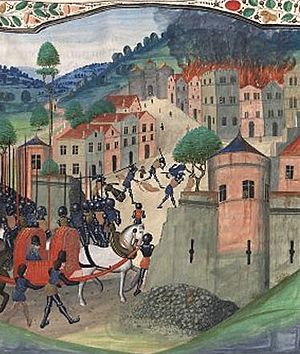Siege of Limoges facts for kids
Quick facts for kids Siege of Limoges |
|||||||
|---|---|---|---|---|---|---|---|
| Part of the Hundred Years' War | |||||||
 |
|||||||
|
|||||||
| Belligerents | |||||||
| Commanders and leaders | |||||||
| Strength | |||||||
| 3,200 | 140 | ||||||
| Casualties and losses | |||||||
| 60 garrison killed 300 civilians killed 200 captured (undifferentiated) |
|||||||
The Siege of Limoges happened in September 1370 during the Hundred Years' War. This long conflict was fought between England and France. The city of Limoges in France had been controlled by the English. However, in August 1370, it switched sides and surrendered to the French, led by the Duke of Berry. Just a few weeks later, an English army arrived to take it back. This army was led by Edward the Black Prince. On September 19, the English attacked and captured the city. This event caused a lot of damage and led to the deaths of many people. It also stopped the famous Limoges enamel industry for about 100 years.
Who Fought at Limoges?
The English army was not very big, with about 3,200 soldiers. It included men-at-arms (knights and armored soldiers), archers, and other foot soldiers. This force was special because it was led by three sons of King Edward III of England. These were Edward, the Prince of Wales (also known as the Black Prince), John of Gaunt, and Edmund of Langley. The Black Prince was quite ill at this time and had to be carried on a special stretcher. They also had experienced military leaders like John Hastings, 2nd Earl of Pembroke and the Captal de Buch.
The French defenders inside Limoges were a much smaller group. The Duke of Berry had left the city with most of his soldiers. He left behind only about 140 men to guard Limoges. The Bishop of Limoges, Jean de Cros, was said to have helped the city surrender to the French earlier. When the English attacked, some French knights, including Sir John Villemur, fought bravely in a town square. They were captured when the city fell.
The Attack on Limoges
The English army began its attack on Limoges in the second week of September. The Black Prince was reportedly very angry that Limoges had surrendered to the French. He wanted to punish the city for changing sides.
When the English broke through the city walls on September 19, there was a lot of fighting and destruction. The old stories about what happened next are different. The historian Jean Froissart wrote that the Black Prince was filled with anger. Froissart claimed that 3,000 people—men, women, and children—were killed. He said this went against the rules of chivalry, which was the code of conduct for knights. However, Froissart's writings are sometimes seen as favoring the French side, even though he had worked for the English queen earlier.
What Really Happened?
Other historians and records give different numbers for the casualties. Some sources from the time mention only 300 civilians being killed. Other old records do not mention civilian deaths at all, focusing more on property damage. One historian, Jonathan Sumption, suggests that around 300 civilians and 60 soldiers from the French garrison died.
A letter from the Black Prince himself, found more recently, also casts doubt on Froissart's high numbers. This letter states that 200 prisoners were taken, but it does not mention any civilian deaths.
Historians today still discuss what truly happened. Some believe that while there was destruction and some civilian deaths, the numbers were much lower than Froissart claimed. They suggest that the Black Prince's actions were partly due to his illness and his frustration. He might have wanted to punish the city for what he saw as betrayal. He also might have wanted to take the city's wealth because he knew he couldn't hold onto the territory for long.
Most historians agree that there was widespread damage to buildings and that some civilians died. However, the idea of a huge massacre of thousands is often questioned.

